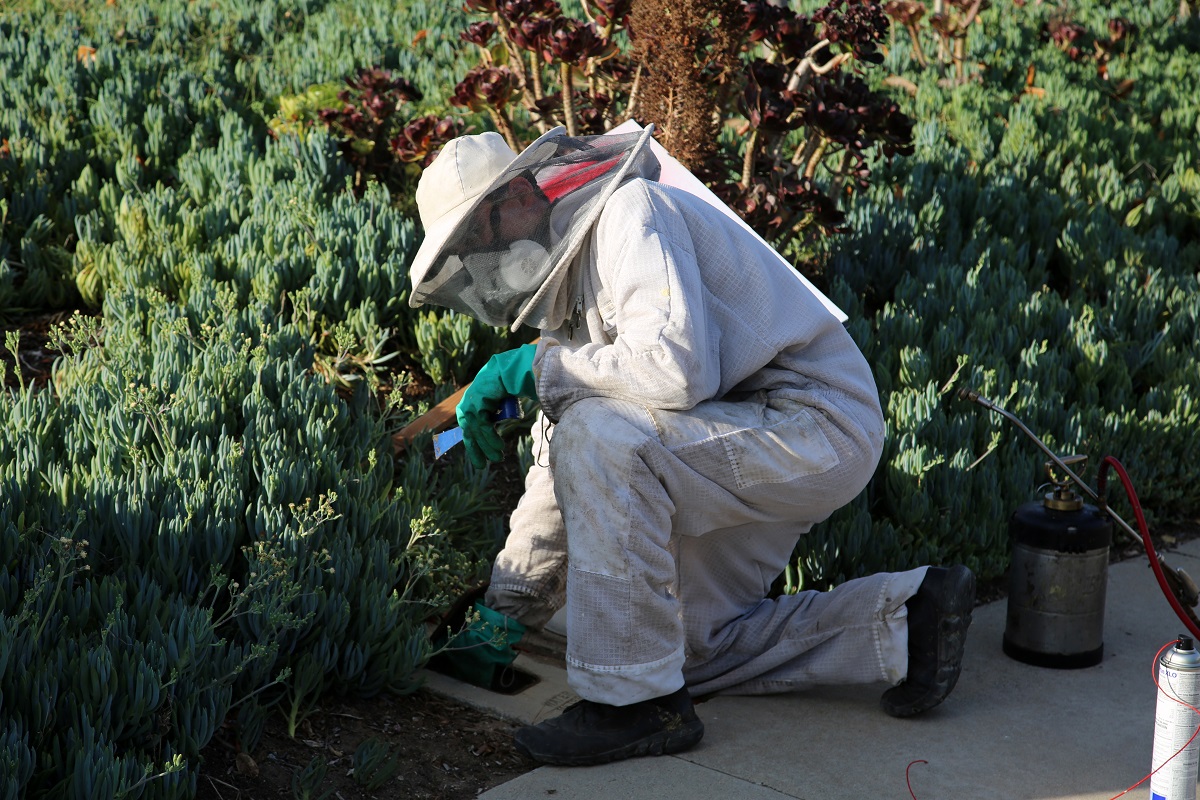The summer months bring back many of our insect friends, including bees and wasps. Unfortunately, these specific insects carry the possibility of being stung, especially if near or around your property. The National Pest Management Association (NPMA) states that more than half a million emergency room visits per year are the result of an insect sting. If you come across a nest, follow this guide to safely conduct a bee and wasp removal.
Identify Your Visitors
Check your yard for any nests created by bees and wasps. The location where you might find a nest depends on the type of stinging insect you’re dealing with. Sometimes you may find a nest in higher areas such as a porch ceiling, other times in lower areas such as under the porch steps. Please take extreme caution as some insects are more aggressive than others.
Bees
Bees pollinate plants and make their nests from wax. While honeybees aren’t hostile by any means, they will sting in order to protect themselves. In the situation of a honeybee nest, contact a local beekeeper to remove the nest from your home and to check if they can be relocated.
Paper wasps
A paper wasp nest is easy to remove safely from your property. These wasps like to build their nests out of the papery chewed wood pulp and these nests aren’t covered, leaving the comb completely exposed. This makes applying a pesticide very easy and simple. Only a few paper wasps may reside in the nest and they are not usually hostile but will attack in self-defense.
Yellow jackets
You can often find yellow jackets in a nest sheltered with a paper-like envelope. The Michigan State University Extension says that these wasps range from hundreds to thousands per nest. They are rather violent and attack in large numbers. Hire bee and wasp exterminators to take care of a yellow jacket nest. It could be extremely dangerous to try and spray one of these nests on your own.
Understand the Level of Threat
Sometimes the safest choice is to not do anything at all. If the nest is out of the way from where kids play or is located a safe distance from your home, it would be wise to leave it alone altogether. The problem could fix itself since most stinging insects only reside in the nests for a year. Once they leave, it is abandoned. If that is the case, avoiding harmful chemicals is a safe choice.
However, if the nest is within an alarming distance of your home, continue reading.
Use the Proper Tools
Using the proper safety tools and gear is the first step in conducting your own bee and wasp removal. Items like an insect spray intended for wasps and hornets and a ladder for higher up nests are a good starting point. Use a bee hat, protective eyewear, and thick gloves as well. Depending on your situation, read the product label before purchasing it. Take for example that some sprays may only be used outside, therefore stinging insect exterminators are required for nests found in the house. If the nest is in the ground, a cloud of insecticidal dust may be used at the entrance of the nest to kill the insects within one to two days.
Work at Night
More insects are likely to be in their nest and are less active during the evening. Wearing long-sleeve shirts and long pants stuffed into your socks are great additions to your protective uniform for the task. Be sure to remove all children and pets from the area as a safety precaution. If you need to shine a light on a nest, do so with a red filter; otherwise, refrain from doing it. Dead insects will fall to the ground, so stand to the side of the nest as opposed to under it when you spray a nest higher up. Spray the nest according to the instructions on the pesticide label and move away as fast as possible.
Give a Little Time before Removing the Nest
The next day, inspect to see if there are any insects left. If there is still insect activity, complete the process again at night. If the nest is completely empty, use a rake handle or something similar in length to remove the nest from a higher location. As an added safety measure, spray the insecticide on other fractures of the nest that have fallen. Be sure to clean up! Throw away the nest and dead insects to prevent your pets or other animals from consuming them.
It is perfectly fine if you are uncomfortable doing this process yourself. If so, contact a professional pest controller to conduct a safe bee and wasp removal instead.
